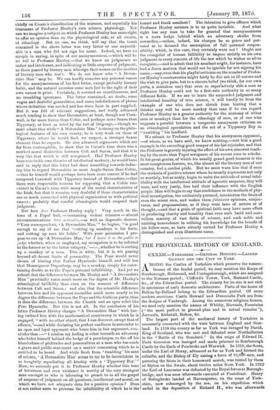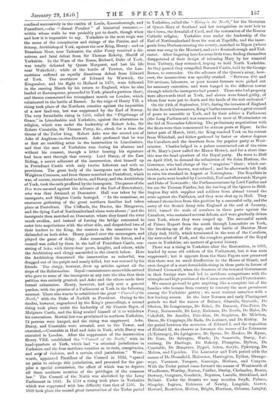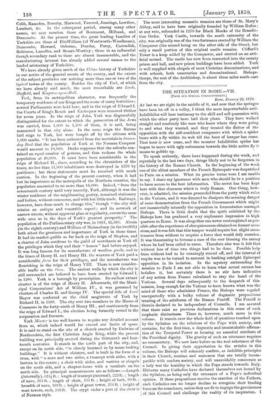THE PROVINCIAL HISTORY OF ENGLAND..
=M.-YORKSHIRE :-GENERAL HISTORY.-LANDED GENTRY AND THE CITY OF YORK.
AMONG the Castles of Yorkshire which preserve the remem- brance of the feudal period, we may mention the Keeps of Scarborough, Richmond, and Coningsborough, which are assigned to the Norman period ; Clifford's Tower, York, Barnard Castle,. &c., of the Edwardian period. The county for its size is not rich in specimens of early domestic architecture. Parts of the house of, Bolton-by-Bolland belong to the Edwardian period. Of more modern erections, Castle Howard and Duncombe Park are from, the designs of Vanbrugh. Among the numerous religious houses, we need only mention the names of Whitby, Rievaulx, Fountains. (" the most perfect in ground-plan and in actual remains "), Jervaulx, Kirkstall, Bolton, &c.
The largest part of the media3val history of Yorkshire is necessarily connected with the wars between England and Scot- land. In 1138 the county as far as York was ravaged by David, King of Scotland, who was met and defeated near Northallerton in the "Battle of the Standard." In the reign of Edward H.. Piers Gaveston was besieged and made prisoner in Scarborough Castle by the Earls of Pembroke and Warwick. In 1319, the Scots, under the Earl of Moray, advanced as far as York and burned the suburbs, and the Bishop of Ely raising a force of 10,011 men, and pursuing the Scots in their homeward march, was routed by them at Myton on the Swale, about twelve miles from York. In 1322 the Earl of Lancaster was defeated by the Royal forces at Borough- bridge, and was soon afterwards executed at Pontefract. Henry of Bolingbroke landed at Ravenspurne, on the coast of York- shire, now submerged by the sea, on his expedition which ended in the deposition of Richard II., who was afterwards confined successively in the castles of Leeds, Kuaresborough, and Pontefract,—the "dismal Pomfret" of historical romance,— within whose walla he was probably put to death, though when and how it is impossible to say. Yorkshire in the next reign was the scene of the conspiracies and risings of the Percies, and of Scroop, Archbishop of York, against the new King, Henry ; and on Bramham Moor, near Tadcaster, the elder Percy received a dis- astrous and fatal defeat from Sir Thomas Rokeby, Sheriff of Yorkshire. In the Wars of the Roses, Richard, Duke of York, was totally defeated by Queen Margaret, and lost his life near Wakefield ; while at the battle of Towton, the Lan- castrians suffered an equally disastrous defeat from Edward of York. The overthrow of Edward by Warwick, the Kingmaker, and his flight to Holland in 1470, were followed in the ensuing March by his return to England, when he also landed at Ravenspurne, proceeded to York, placed a garrison there, and thence commenced his triumphant march on London, which culminated in the battle of Barnet. In the reign of Henry VII. a rising took place of the Northern counties against the imposition of a new land-tax, but was suppressed by the Earl of Surrey. The very formidable rising in 1536, called the "Pilgrimage of Grace," in Lincolnshire and Yorkshire, against the alterations in religion, which was under the leadership of Robert Aske, Sir Robert Constable, Sir Thomas Percy, &c., shook for a time the throne of the Tudor king. Robert Aske was the second son of Aske of Aughton-on-the-Derwent. Aske professed that he was at first an unwilling actor in the insurrection in Lincolnshire. and that the men of Yorkshire rose during his absence and without his consent, though a letter bearing his signature had been sent through that county. Lord Darcy, of the East Riding, a secret adherent of the insurrection, abut himself up in Pontefract Castle with only twelve followers and with no provisions. The great body of the insurgents met on Market- Weighton Common, and from thence marched on Pontefract, which was, of course, surrendered to them, and Darcy, and the Archbishop of York, took the oath proffered by the insurgents. The passes of the Din were secured against the advance of the Earl of Shrewsbury, who was thus detained at Doncaster. Hull was taken by the insurgents, and Skipton Castle besieged. "In the meantime, an enormous gathering of the great northern families had taken place at Pontefract. The Cliffords, the Dacres, the Musgraves, and the dying Earl of Northumberland alone were absent ;" and the insurgents then marched on Doncaster, where they found the river much swollen, and instead of forcing the bridge consented to enter into negotiations with the other side, and despatched two of their leaders to the King, the musters in the meantime to be disbanded on both sides. Henry gained over the messengers, and played the game of delay. Aske reassembled his forces, and a council was called by them in the hall of Pontefract Castle, con- sisting of Aske, with thirty-four peers, knights, and others, while the Archbishop and clergy assembled in the church below. Here the Archbishop denounced the insurrection as unlawful, was dragged out of the pulpit and nearly killed, but was rescued by his friends. The clergy, however, drew up articles against all the steps of the Reformation. Royal commissioners meanwhile arrived who gave to some of the insurgents at any rate the idea that their petition was entirely granted, and Aske and the others made their formal submission. Henry, however, had only sent a general pardon, with the promise of a Parliament at York in the following summer. There also was to be established the great "Council of the North," with the Duke of Norfolk as President. Owing to the doubts, however, engendered by the King's proceedings, a second rising took place under the leadership of Sir Francis Bigot, of Mulgrave Castle, and the King availed himself of it to withdraw his concessions. Martial law was proclaimed in northern Yorkshire, 74 persons were hanged, and the rising was suppressed. Aske, Darcy, and Constable were arrested, sent to the Tower, and executed,—Constable in Hull and Aske in York, while Darcy was executed in London. After the suppression of the insurrection Henry VIII. established the " Council of the North," with its head-quarters at York, which had "a criminal jurisdiction in Yorkshire and the four northern counties as to riots, conspiracies, and act, of violence, and a certain civil jurisdiction." Went- worth, appointed President of the Council in 1C82, "spared no pains to enlarge this jurisdiction, and procured for the pur- page a special commission, the effect of which was to deprive all these northern counties of the privileges of the common law." The Council of the North was abolished by the Long Parliament in 1641. In 1548 a rising took place in Yorkshire which was suppressed with less difficulty than that of 1536. In 1,569 took place the second great insurrection of the Tudor period
in Yorkshire, called:the "Rising in the North," for the liberation of Queen Mary of Scotland and her recognition as next heir to the Crown, the downfall of Cecil, and the restoration of the Roman Catholic religion. Yorkshire rose under the leadership of the Earl of Northumberland from his seat at Topcliffe, and the insur- gents from Durham entering the county, marched to Ripon (where mass was sung in the Minster), and so to Knaresborough and Tad- caster. After lingering here for some little time, finding themselves disappointed of their design of releasing Mary by her removal from Tutbury, they retreated, hoping to hold North Yorkshire. As they passed they compelled Barnard Castle, held by Sir George Bowes, to surrender. On the advance of the Queen's army, how- ever, the insurrection was speedily crushed. "Between 600 and 700 artizans, labourers, or poor tenant-farmers were picked out for summary execution, and were hanged in the different towns through which the insurgents had passed. Those who had property were afterwards tried at York, and eleven were found guilty, of whom four were put to death and the lands of the rest escheated."
On the 24th of September, 1640, during the invasion of England by the Scotch Covenanters, King Charles sutunioned a great council of peers to assemble at York, and by their advice a Parliament (the Long Parliament) was summoued to meet at Westminster on the 3rd of November following. The preliminary negotiations with the Scots were then commenced by sixteen peers at Ripon. In the latter part of March, 1642, the King reached York on his retreat from Whitehall, and hither gathered by faster or slower degrees time Cavaliers and the deserters froin the popular party at West- minster. Charles lodged in a palace constructed out of the ruins of St. Mary's (now called the Mauor House), and for a short time this was the head-quarters of the Royal party. He went to Hull on April 23rd, to demand the submission of Sir John Hotham, the Governor, who had charge of the " magazine" there ; which sur- render, as is well known, was refused ; and he afterwards left York to raise his standard in August at Nottingham. 'rile Royalists in these parts were headed by Cavendish, Earl and afterwards Marquis and Duke of Newcastle ; the Parliamentarians by Lord Fairfax and his son Sir Thomas Fairfax, but the lauding of the Queen in Brid- lington Bay with supplies and soldiers from abroad turned the scale against the Fairfaxes, and they were shut up in Hull. They released themselves from this position by a successful sally, and the entry of the Scotch Army into England at the end of January, 1644, turned the scale of munbers in those parts against the Cavaliers, who sustained several defeats, and were gradually driven into York, where they were cooped up. The successful march of Prince Rupert from the south through Lancashire on York, the breaking-up of the siege, and the battle of Marston Moor (July 2nd, 1644), which terminated in the rout of the Cavaliers, the surrender of York, and the complete prostration of the Royal cause in Yorkshire, are matters of general history.
There was a rising in Yorkshire after the Restoration, in 1663, headed by some old soldiers of the Parliament, but it was soon suppressed ; but it appears from the State Papers now preserved that there was no small disaffection, to the House of Stuart, and even danger of a more formidable rising in these parts in favour of Richard Cromwell, when the disasters of the restored Government in their foreign wars had led to invidious comparisons with the triumphs and high position of the Commonwealth awl Protectorate. We cannot pretend to give anything like a complete list of the families who became from century to century the most prominent among the Yorkshire gentry ; we must content ourselves with a few leading names. In the later Norman and early Plantagenet periods we find the names of Buttner, Glanvile, Stutevile, De Oketou, De Longscamps, De Bobei, De Batuent, Fitz-Peter, De Percy, Normanvile, De Lacy, Rademan, De Nevile, De Hales, De Cokefeld, De Ascelle,s, Fitz-Alan, De Stapleton, De Midelton, Dacre, De Creppings, De Bada, De Latimer, and De Kirkby. Itt the period between the accession of Edward I. and the deposition of Richard II. we observe as foremost the names of Le Estraneus
(L'Estrange), De Lythgrenes, De I3yrun, De Hookes, De Kyme,
Be Eure, De Salvayne, Warde, De Somervile, Darcy, Fal- conberg, De Hastings, De Rokeby, Plumpton, Hylton, De
Constable, De Musgrave, Bygod, Acton, Savyle, Pykeryng, De Melton, and Upeeden. The Lancaster and York period adds the names of De Dronsfield, Maleverer, Harrington, Ryther, Strange-
ways, Vavasour, Tempest, Gascoign, Hothatn, and Conyers.
With the Tudor period come forward the names of Wentworth of Woodhouse, ‘Vortley, Norton, Fairfax, Danby, Cholmeley, Bowes, Dawney, Gargrave, Goodrick, Boynton, Lascells, Strickland, and Bellaais. Under the Stuarts we may mention Swyft, Palmes, Slingsby, Ingram, Robinson of Newby, Langdale, Gower, Howard, Bourchier, Hutton, Bright, Harrison, Osborne, Langley, Cobb, Ramsden, Reresby, Marwood, Tancred, Jennings, Lowther, Lambert, &c. In the subsequent period, among many other names, we may mention those of Beaumont, Milbank, and Duncombe. At the present time, the great leading families of Yorkshire are those of FitzWilliam (of Wentworth-Woodhouse), Duncombe, Howard, Osborne, Dundas, Percy, Cavendish, Robinson, Lascelles, and Stuart-Wortley; those in an influential though secondary rank to these are almost innumerable, and the manufacturing interest has already added several names to the landed aristocracy of Yorkshire.
We have already given much of the Urban history of Yorkshire in our notice of the general events of the county, and the extent of the subject precludes our noticing more than one or two of the typical towns of the county. Besides the city of York, of which we have already said much, the most remarkable are Leeds, Sheffield, and Kingston-upon-Hull.
York, from its metropolitan character, was frequently the temporary residence of our Kings and the scene of many festivities ;
several Parliaments were held here, and in the reign of Edward I.
the Courts of King's Bench and Exchequer were removed thither for seven years. In the reign of John, York was disgracefully distinguished for the extent to which the persecution of the Jews was carried, from 1,000 to 1,500 of them, it is said, being massacred in that city alone. In the same reign the Barons laid siege to York, but were bought off by the citizens with
1,000 marks. "it has been estimated from the materials in Domes- day Book that the population of York at the Norman Conquest
would amount to 10,000. Drake supposes that the suburbs con- tained an equal number of persons, and thus reckons the whole population at 20,000. It must have been considerable in the reign of Richard II., since, according to the chroniclers of the times, no less than 11,000 inhabitants were destroyed in 1370 by pestilence ; but these statements must be received with much caution. In the beginning of the present century, when it had lost its importance as the metropolis of the Northern counties, the population amounted to no more than 16,000. Indeed, "from the seventeenth century until very recently, York, although it was the winter residence of the neighbouring gentry, remained stationary and listless, without commerce, and with but little trade. Railways, however, have done much to change this," though "the city still retains an antique and venerable aspect ; and its network of narrow streets, without apparent plan or regularity, covers the same wide area as in the days of York's greatest prosperity." The population of the Parliamentary city was, in 1861, 45,385. Alcuin (in the eighth century) and William of Malinesbury (in the twelfth) both attest the greatness and importance of York in those times.
It had its market-guilds as far back as the reign of Stephen, and a charter of John confirms to the guild of merchants at York all the privileges which they and their " houses " had before enjoyed.
It was long famous for its manufacture of woollen goods, and in the times of Henry IL and Henry III. the weavers of York paid a
considerable farm for their privileges, and the manufacture was flourishing in the reign of Henry VIII. There is now consider- able traffic on the Ouse. The ancient walls by which the city is still surrounded are believed to have been erected by Edward I. in 1280. York is a borough by prescription. Its earliest extant
charter is of the reign of Henry II. Afterwards, till the Muni- cipal Corporations' Act of William IV., it was governed by
charters of Charles IL and George IV. The special title of Lord
Mayor was conferred on the chief magistrate of York by Richard II. in 1389. The city sent two members to the House of Commons in the forty-ninth of Henry III., and continuously from the reign of Edward I., the election being formerly vested in the corporation and freemen.
York Minster is too well known to require any detailed account from us, which indeed would far exceed our limits of space.
It is said to stand on the site of a church erected by Eadwine of Northumbria, the first Christian Angle King, while the present building was principally erected during the thirteenth and four- teenth centuries. It stands in the north part of the city, and, except on its north side, "is closely hemmed in by mean-looking buildings." It is without cloisters, and is built in the form of a cross, with "a nave and two aisles, a transept with aisles, with a lantern in the centre ; a choir with aisles, and vestries or chapels on the south side, and a chapter-house with a vestibule on the north side. Its principal measurements are as follows :—Length (internally), 524i ft.; length of transept (internal), 222ft. ; length of nave, 264 ft. ; length of choir, 131 ft. ; height of both, 99 ft. ; breadth of nave, 169 ft. ; height of great tower, 234 ft. ; height of west towers, each, 196 ft. The crypt under a part of the choir is of Norman style. The most interesting monastic remains are those of St. Mary's Abbey, said to have been originally founded by William Rufus ; at any rate, refounded in 1270 for Black Monks of the Benedic- tine Order. York Castle, towards the south extremity of the city, was originally one of the two fortresses erected by William the Conqueror (the second being on the other side of the Ouse), but only a small portion of this original castle remains. Clifford's Tower is a keep added by the Conqueror, and erected on an arti- ficial mound. The castle has now been converted into the county prison and hall, and new prison buildings have been added. York is well supplied with chapels of most Christian denominations, and with schools, both unsectarian and denominational. Bishops- thorpe, the seat of the Archbishop, is about three miles south-east from the city.




































 Previous page
Previous page